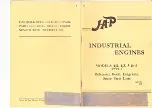
28 l
Installation, operation and maintenance manual – Squirrel cage motor – WGM20 Line 14108242
When flexible couplings are used, greater values than
those indicated above are acceptable, provided that they
do not exceed the value allowed by the coupling
manufacturer.
It is recommended to keep a safety margin for these
values.
In the alignment/leveling, the influence of the
temperature on the motor and the driven machine must
be taken into account. Different expansions of the parts
may change the alignment/leveling conditions during
operation.
4.8.7
Doweling
After aligning the set and having assured a perfect
alignment
(both, hot and cold)
, the motor must be
doweled to the anchor plate or to the base, as shown in
Figure 4.11.
Figure 4.11: Dowel pin set
Figure 4.11 legend:
1.
Dowel pin (optional supply)
2.
Nut (optional supply)
3.
Washer (optional supply)
NOTE
For the doweling, the motor has a pre-hole
with Ø9 mm, which must be first expanded
to Ø11.5 mm, and then reamed to Ø12 mm
with a taper of 1:50.
4.8.8
Couplings
Only proper couplings, which convey only torque without
generating transversal forces, must be used.
For both flexible and rigid couplings, the shaft centers of
the coupled machines must be in a single line.
Flexible couplings mitigate the effects of residual
misalignments and prevent transmission of vibration
between the coupled machines, which does not occur
when rigid couplings are used.
The coupling must be mounted or removed with the aid of
proper devices and never by means of rudimentary tools,
such as hammers, sledgehammers, etc.
ATTENTION
Dowel pins, nuts, washers and leveling shims
may be supplied with the motor, when
requested in the purchase order.
NOTES
The user is responsible for the motor
installation (unless otherwise specified by
commercial agreement).
WEG is not liable for damages to the motor,
associated equipment and installation
occurred because of:
Transmission of excessive vibration;
Poor installations;
Faulty alignment;
Improper storage conditions;
Noncompliance with the instructions
before start-up;
Incorrect electrical connections.
4.8.8.1
Direct coupling
Because of issues about cost, space economy, problems
with belt sliding and more safety against accidents, direct
coupling must be used whenever possible. Also, direct
coupling is preferable in case of transmission with
reduction gearing.
ATTENTION
Align the shaft ends carefully, and, whenever
possible, use flexible coupling, leaving a
minimum clearance (E) of 3 mm between the
couplings, as shown in Figure 4.12.
Figure 4.12: Axial clearance of the coupling (E)
4.8.8.2
Gear coupling
Gear couplings badly aligned generate vibration in the
transmission itself and in the motor. Therefore, caution
must be taken so that the shafts be perfectly aligned,
rigorously parallel in case of spur gear transmissions and
in a correct angle in case of transmissions by bevel or
helical gears.
The gear teeth meshing can be controlled with the
insertion of a paper strip, on which the trace of all teeth
shows up after a gear turn.
4.8.8.3
Belt drive
Figure 4.13: Belt drive
Correct
Incorrect
Incorrect
















































